Welcome back after a pause in film making. (I had first proofs of my book to contend with and these films do take so much more time than I imagined). I am also entirely reliant on and extremely grateful to Rod for all production and editing and he had other things to do!
The idea of libum functions on many levels in the ancient evidence . It can be a generic idea of ‘cake’ of potentially many different recipes and styles or it can be the specific sacrificial cheese-cake that is found in the recipe that survives in Cato’s agricultural manual. It is not always clear from the evidence whether we should always think in terms of the Cato recipe, which appears in this manual precisely because such cakes were considered necessary to please the gods and allow the farm to prosper. It rather depends on the context. The earliest sources such as Varro, define these cakes entirely as sacrificial offerings:
‘Libum cake because after it was cooked as an offering there was an offering of some of it to the Gods before it was eaten’ Varro, De Lingua Latina 5.106.3
they are so named because part of them are offered to the gods at sacrifices, and part eaten by the celebrants. That these cakes were made sub testu with a testum – a portable oven for baking single cakes, one at a time and therefore fresh – is made clear by Varro too
‘Testuacium (libum)’ testum cake because it was baked in an heated testum as even now the matrons do this at the Matralia‘ (in celebration to Mater Matuta in June)
The Roman God that was originally given these cakes was called Liber unsurprisingly! In ancient Roman religion Liber was the equivalent of Bacchus, and was similarly associated with wine, fertility and freedom. Ovid explains why Bacchus is offered honey cakes, it is simple that he delights in sweet things. (Fasti III.735). He also asked why it was that old women make these cakes: It is because at the time of the first popular strike in Rome, the plebs fled to the sacred mount in 494BC and as they had no bread they survived by being fed cakes served hot to them by Anna Perenna (Ovid fasti III. 670). He also explains that old women continued to traditionally make these cakes to sell fresh at festivals.
In comparing the town and country style of living Horace says
‘like the priest’s runaway slave, I reject libum, I want bread and prefer it to honied placenta’ Horace Ep 1. 10. 10
That priests owned slaves that worked for them at the temple precinct is made clear and also clear that these slaves were fed on the sacrificial cakes left by the celebrants. The reference to placenta is intriguing. It is another sacrificial cake from Cato’s agricultural manual which has both a religious significance as an offering and also a potential place at the feast – we shall return to placenta in the months to come.* Other sources talk of birthday ‘libum’ again ‘offered’ as part of the religious celebration of birth and its anniversary, but also brought as a gift, dripping with honey and one has to assume desirable, and consumed by the family (Tibullus, Elegiae 1.7.54). What seems clear from the experiments so far is that when made with fresh cheese, consumed freshly baked, and with warmed honey they are quite exceptionally delicious and fit for a feast but when allowed to go cold and when made with firmer cheese and courser flour they are some what stodgy and dense and as a result far less appealing.
75. Recipe for libum: crush 2 pounds of cheese thoroughly in a mortaria. When it is thoroughly crushed, add 1 pound of wheat flour or if you wish the cake to be more dainty 1/2 pound of fine flour, and mix thoroughly with the cheese. Add 1 egg and work the whole well. Pat into a loaf shape, place in leaves, and bake slowly on a warm hearth under a testum’
Bear in mind that 1 ancient pound is equivalent to 12 of our ounces so the recipe works out as follows.
2 Roman pounds = 24 oz = 1lb 8oz cheese. = 650 gm cheese 1 Roman pound = 12 oz flour = 325 gm flour OR if finer cake required 6 oz flour or = 160 gm 1 egg
A full modern recipe is at the bottom of the page.
Cato’s recipe comes in two qualities depending on the quantity and quality of the flour added and also the cheese. One could end up with a beautiful delicate soft cake dripping with honey or a hefty dense course and salty loaf that might and probably did hang around on the alter for some time and some of the offerings may never have been consumed in reality. A standard cake is made with 2 lb of wheat flour and we may assume that, as the other kind of flour is finer, the standard cake was probably made with a courser grade of flour and even whole-wheat flour. The alternative finer flour is not only finer but it is added at half the quantity of the whole-wheat version.
What can we say about the cheese ? It is likely to be goat or sheep’s cheese simply because cows were not milked as much as today. i could of sought out either but i was luck to have access to goats milk in the village. A goats cheese could be fresh and sweet or salty, crumbly and aged. I have replaced the cheese with various substitutes in the past mascarpone as I tried in the first film and ricotta – which is by far the best for trying this at home – and as you will see with the second film a freshly made goat or sheep cheese is best of all.
We are surely looking for a Queso fresco here which can be mild, soft, or some what crumbly and similar to a mild feta. Its also called pot cheese and farmer cheese, Indian paneer and Eastern European quark, all of which are defined as ‘new’ and with a short shelf life. A harder saltier cheese is possible too but this necessarily has far less moisture and with that single egg as well – that I have such problems with – the resulting cake is going to be a pretty firm and dense again. Add the concept of a course whole-wheat flour and the denseness increases again. The recipe for the flat cake known as placenta * includes detailed instruction to render a cheese suitable for making cakes and while this is not included in the libum it is interesting to consider the nature of the cheese before the process begins.
‘soak 14lb of sheep’s cheese (sweet and quite fresh) in water and let it soak, changing the water three times. Take out a small quantity at a time, squeeze out the water thoroughly with the hands, and when it is quite dry place it in a bowl. When you have dried out the cheese completely, knead it by hand to make it as smooth as possible. Then take a clean flour sifter and force the cheese through it into the bowl’ (Cato de re rustica 76)
This is quite a c0mplex procedure to engage with even with a cheese purporting to be sweet and fresh, and one has to imagine a cheese stored in brine or one that is firm in texture and crumbly in order for this to be necessary.
I have most often made this cake with a ricotta but I have also used feta and as with the first film a mascarpone. This makes a very rich but quite flat cake. It does require more flour to prevent the cake from spreading but then it loses its soft texture. For the purpose of duplicating this at home ricotta is best by far but the feta is interesting too. The cake using feta is salty and firm and one might say a savoury option as apposed to the soft honey cake. This is how I originally interpreted these cakes in the Classical cook book. We were very lucky to find that our neighbours kept a few goats and were willing to be filmed. Cheryl Jackson was a great sport and helped immensely with advice about cheese making. Incidentally that glorious view she has over her valley is the same valley as ours, we share that sense of peace that comes with woodland living.

To make the cheese I employed the simplest basic method I could find, which could not be include on the film. I warmed 4pts of the milk to 27°C (80°F), added an acidifier – 3-4 tsp vinegar, lemon juice, or in the case of the instructions from Columella, the milky juice from freshly torn fig leaves – and waited for it to coagulate. The latter was not as easy as it sounds as the juice is very difficult to extract in that quantity and I gave up after a while of waiting and added a little extra lemon juice and it curdled straight away. 2 tsp of salt is also added at this point.
After leaving the milk to cool and coagulate I passed it through a muslin sieve and left it to fully drain for a 3-4 hours. At this point you can gather the edges of the muslin up and tie in a knot. Place weights on top such as a few cans to express as much whey possible. I left mine under weights for 12 hours but you can leave it for long and remove vastly more moisture. At this point I used my cheese but one can envisage a cheese that has been salted more heavily, stored in brine and even dried out and allowed to form a thin crust. Such cheeses were almost certainly made for sale at markets for others to use and had to be salted to preserve them. I suspect in the case of our sacrificial cakes, the cheese was largely made fresh for the purposes of making the cake offerings in a domestic and rural setting where goats and sheep were available but cheese had to be purchased in an urban setting.
Previous libum from re-enactment days.
A modern recipe using ricotta.
325 gm ricotta 160 gm or 80 gm of plain white flour . or 160 or 80 gm of whole-wheat flour 1 very small egg (you can use a standard size and use half but its not really necessary) 3 tbsp of honey warmed
Beat the cheese, add the flour, well sieved if using plain flour, using a spoon combine and then lightly knead. add the egg and stir to combine. Cover your hands in flour and form into a ball. To duplicate the baking technique – to get that lovely crust – try using a le creuset casserole dish. Preheat the oven to 200 ° C. Place the casserole, clean and dry, in the oven and heat for at least 45 mins. When ready to bake, place bay leaves on the base of the casserole and put the cake on top. Return the lid and place in the oven for 25-30 mins, After 20 mins check the colour and setting texture of the cake. Meanwhile warm the honey. When golden brown and set take the cake out and put on a plate. Cut into 8 pieces and pour the honey over. Sprinkle with pepper too it makes it especially delicious and eat as soon as possible!
Try using feta instead of ricotta. soak the cheese in water and change a few times. Beat smooth and even sieve as described for the placenta * above. Use the same ratio of cheese to flour and bake as a savoury cake and serve with smoked meat and pickles.
* The name of this cake and its origins is fraught with problems as we are inevitably compelled to think of the human organ that feeds the embryo. Its a long and complicated story which we will attempt to tell when placenta becomes the topic of a film.
As we may move into a possible lockdown in the next few days in the UK and the rest of Europe is dealing with this growing crisis in a similar way I send best wishes to all. Take care to be safe. Hands, face space.
Sally Grainger xx

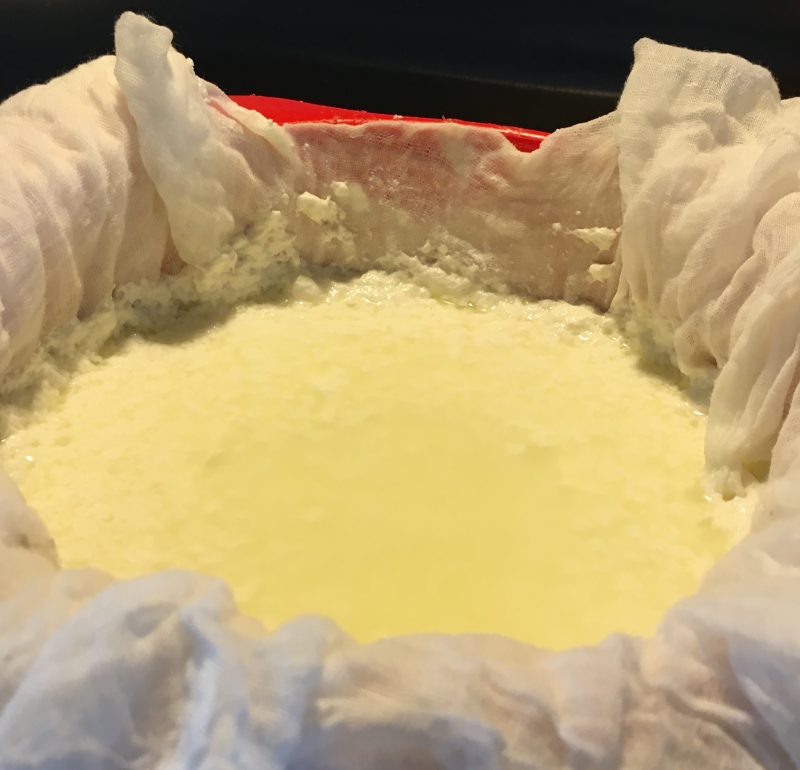

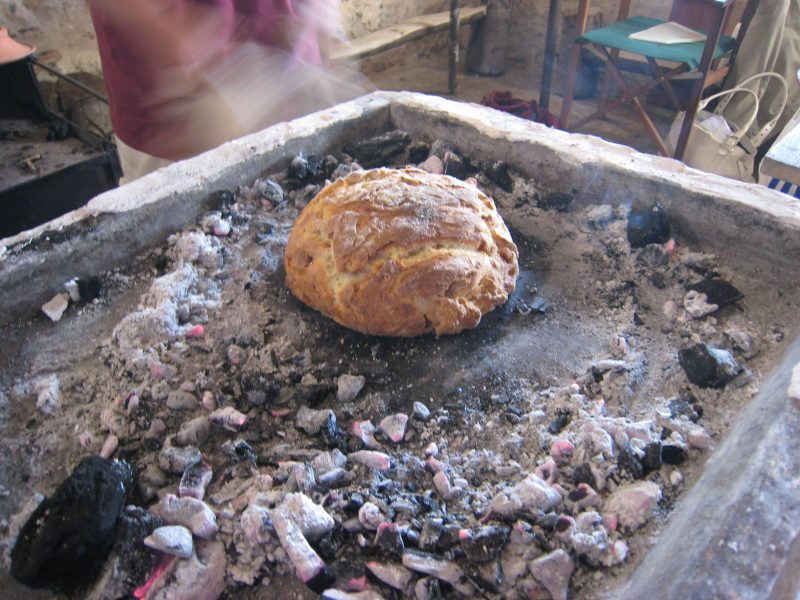
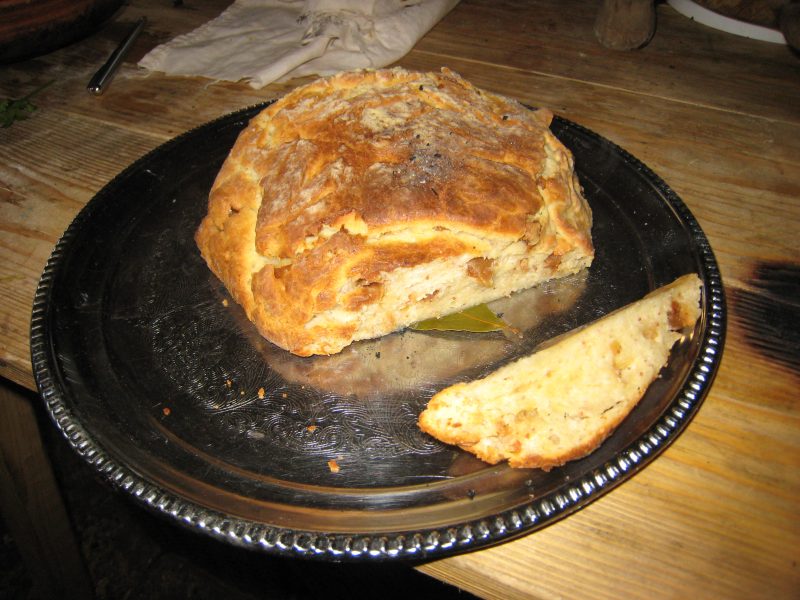
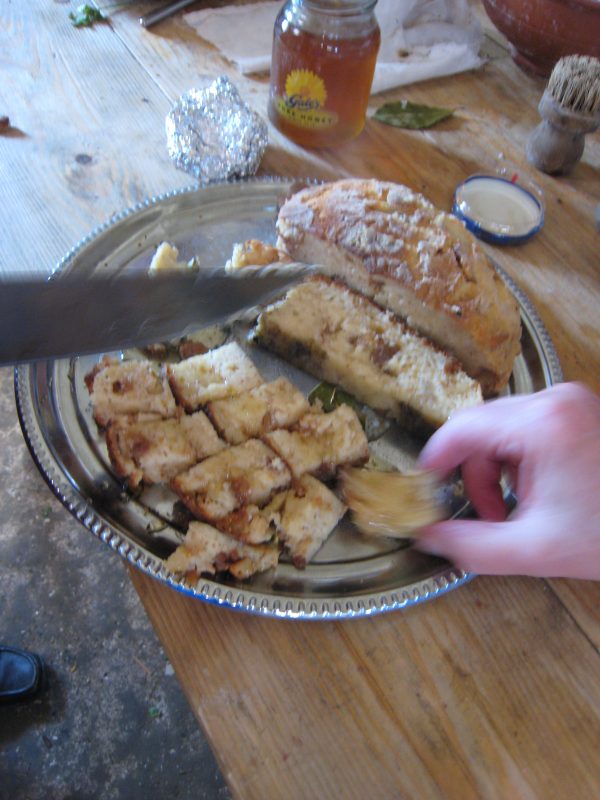
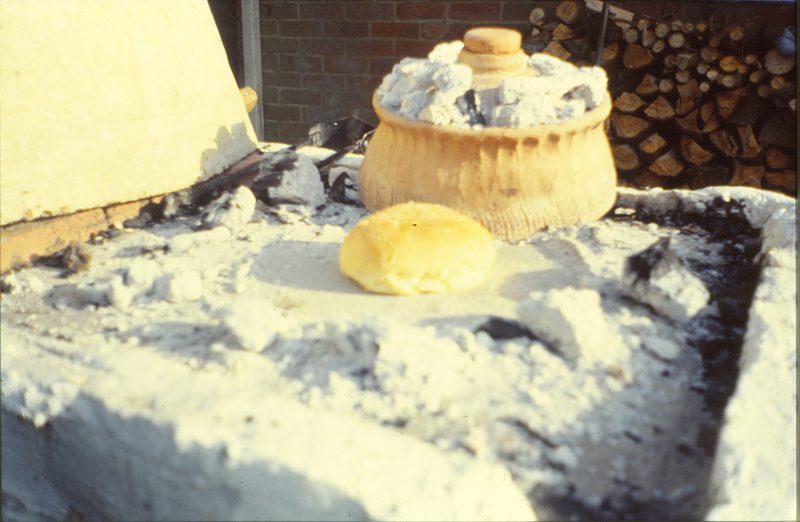
I have experimented with the similar dish, found in Cato, called Savillum. I found the best cheese to be a faux-Ricotta (made from whole milk not whey) that has about 35% solids by weight. Wetter cheeses (around 25%) make a disturbingly squodgy cake if you use Cato’s listed ratio of flour, and don’t taste of cheese if you boost the amount of flour. I like to make Savillum with flour that is a blend of half white cake flour, and half wholemeal flour that I have finely sieved to remove the larger bran pieces.
Hi
I am sorry to have missed your comments. I don’t get many and so I don’t check in as often as should. I agree about the fake ricotta . I also like the idea of sieving out the worst of the wholemeal flakes I may try that.
All the best Sally